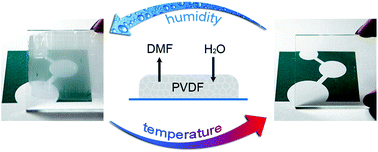Controlling the microstructure of poly(vinylidene-fluoride) (PVDF) thin films for microelectronics
Abstract
PVDF thin films prepared under standard processing conditions have a cloudy appearance and are notoriously rough, which prevent microelectronic and photonic applications. On the other hand, high optical quality, smooth films can be prepared either at low relative humidity or at high substrate temperature. Here we systematically investigate the morphology of PVDF thin films by varying the processing conditions. Films are characterized by SEM and AFM and by measurements of clarity, haze and absorption. We show that the cloudy appearance is due to vapor-induced phase separation (VIPS) as is well-documented for the formation of PVDF membranes. Formation of opaque thin films is a general problem of any ternary polymer/solvent/non-solvent system where a high boiling point solvent is used that is fully miscible with a non-solvent, here water from the ambient.

- This article is part of the themed collection: Fabrication technology of nanomaterials

 Please wait while we load your content...
Please wait while we load your content...